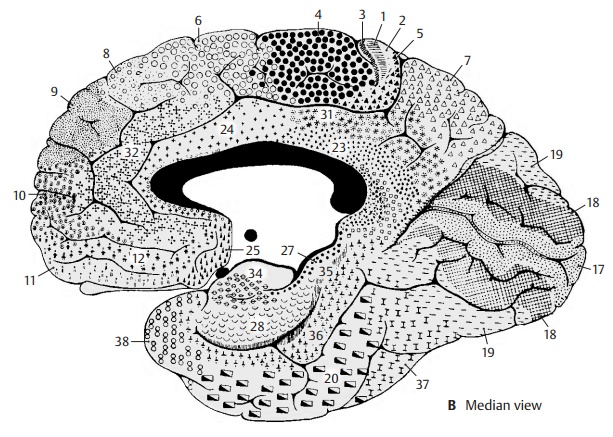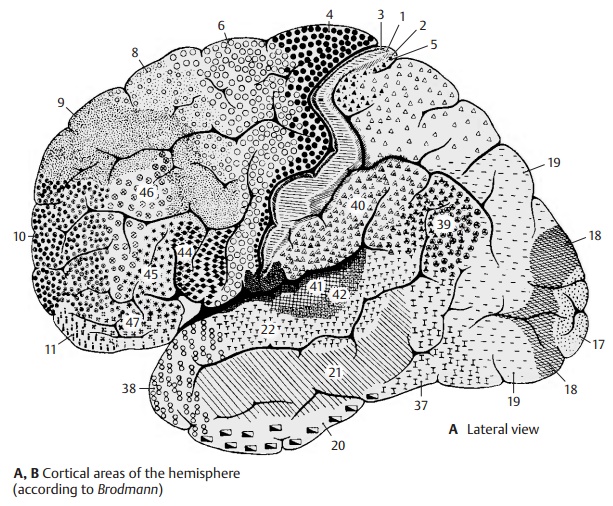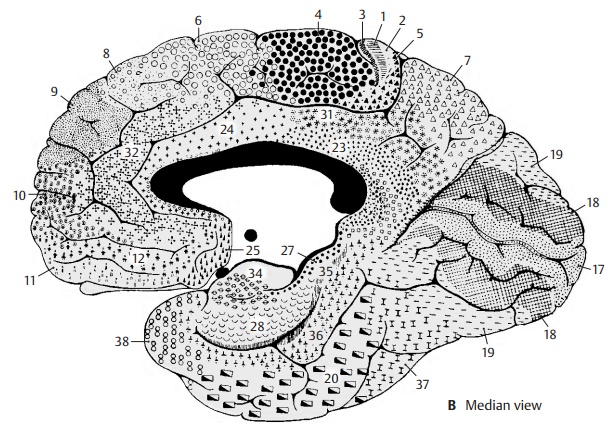Chapter: Human Nervous System and Sensory Organs : Telencephalon
Neocortex: Cortical Areas

Cortical Areas
All
regions of the neocortex develop in a similar way. First, a wide cell layer,
the cortical plate, forms on the
surface of the hemisphere which then divides into six layers. Because of this
similar development, the neocortex is also known as isogenetic cortex, or briefly, isocortex,
or as homogenetic cortex.
Nevertheless,
the adult neocortex exhibits considerable regional variations, and we distinguish
several regions of different structure, the cortical areas. The individual layers may vary considerably in
these areas: wide or narrow, with densely or loosely packed cells. The cells
may vary in size, or a specific cell type may predominate. The definition of
individual areas according to such criteria is called architectonics. Depend-ing on the staining method employed, the
following terms are used: cy-toarchitectonics, myeloarchitectonics, or pig-ment architectonics. A map of
cortical areascan be reconstructed on the surface of the hemisphere, similar to
a geographic map. The cytoarchtectonic map of cortical areas established by
Korbinian Brodmann (A, B) has been confirmed repeatedly and is
gen-erally accepted.

Types of cortices.A special feature of
pro-jection areas (terminals of ascending sensorypathways) is the prominent
development of their granular layers. In the sensory cortex (area 3) as well as
in the auditory cortex (areas 41 and 42, temporal transverse gyri), the
granular layers (layers II and IV) are wide and rich in cells, while the
pyramidal cell layers are less well developed. This type of cortex is referred
to as koniocortex, or granular cortex. The visual cortex (area
17,striate area) even exhibits a duplication of layer IV. These sensory
cortical areas, which are the terminals of afferent projection fibers, are
involved in associative processes, where relay neurons with short axons play an
important role. On the other hand, the granular layers in the motor cortex (areas 4 and 6) are
largely reduced in favor of the pyramidal layers (agranular cortex). The pyramidal cells are projection neuronswith
long axons; for example, in the motor cortex, their axons form the
corticospinal tract (pyramidal pathway).

Border zones.Wherever the isocortexborders on
the archicortex or paleocortex, its structure becomes simpler. The
transi-tional formation with the simpler structure is referred to as proisocortex. The proisocor-tex
includes the cortex of the cingulate
gyrus, the retrosplenial cortex (lying
around the posterior end of the corpus callosum), and parts of the insular cortex. The proisocortexis phylogenetically
older than the neocor-tex.
Paleocortex
and archicortex are also sur-rounded by a border zone, the structure of which
approximates that of the neocortex. The border zones are known as periarchicor-tex and peripaleocortex. The
periarchicortexincludes, for example, the entorhinal
area bordering on the hippocampus.
Allocortex.The allocortex is often
con-trasted with the isocortex. The term refers to the paleocortex and the
archicortex. As both are completely different parts of the telencephalon,
genetically as well as struc-turally and functionally, this collective term is
not justified. The only thing they have in common is that they are different
from the isocortex. Their simpler structure (for ex-ample, no stratification
into six layers as it is characteristic for the neocortex) does not justify to
label them as primitive regions. Rather, they are phylogenetically old, highly
specialized structures.
Related Topics